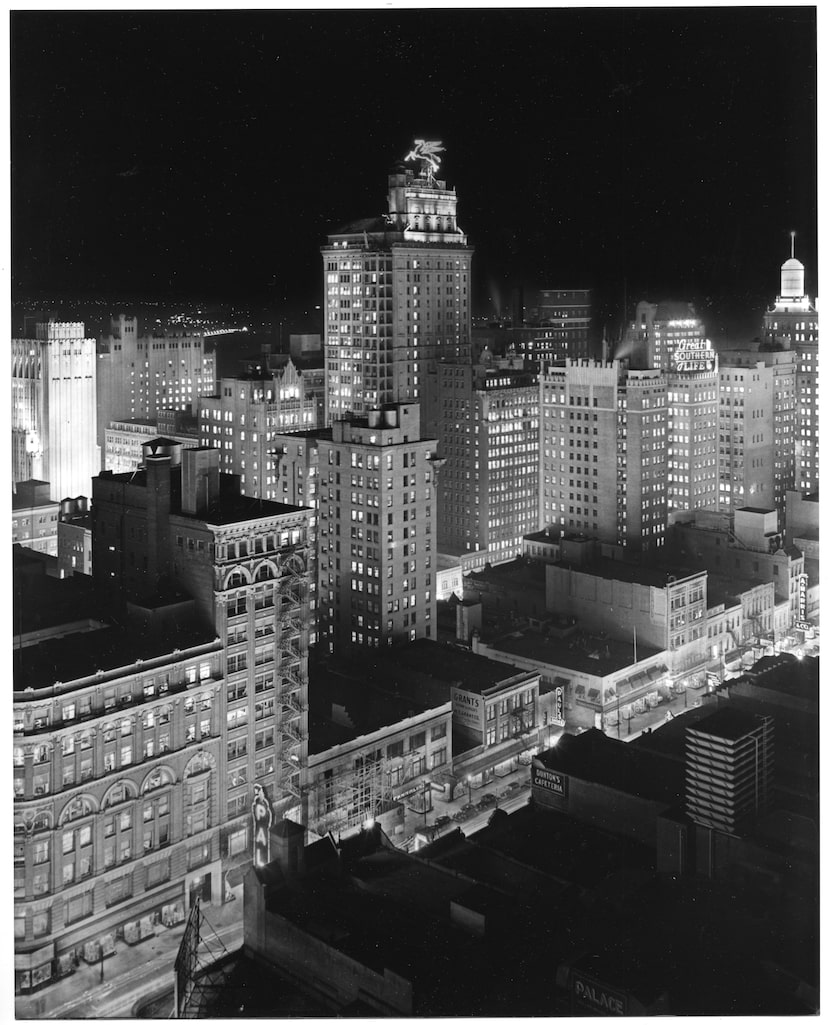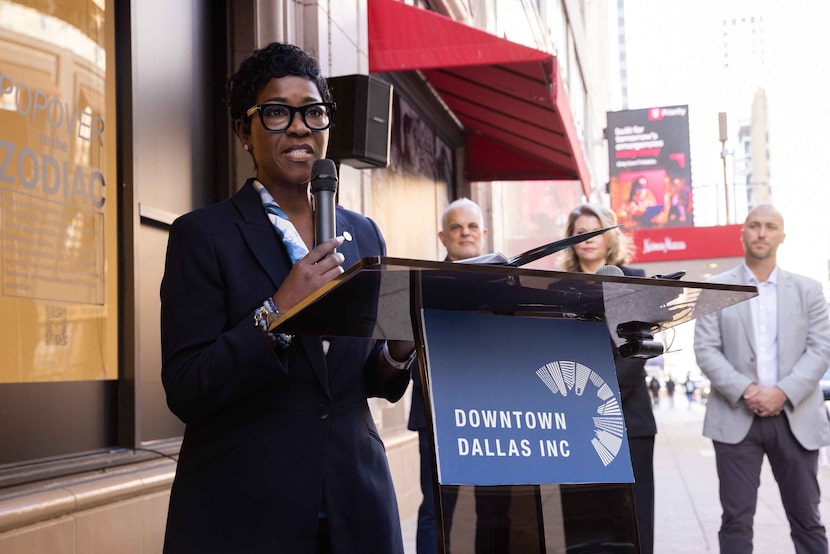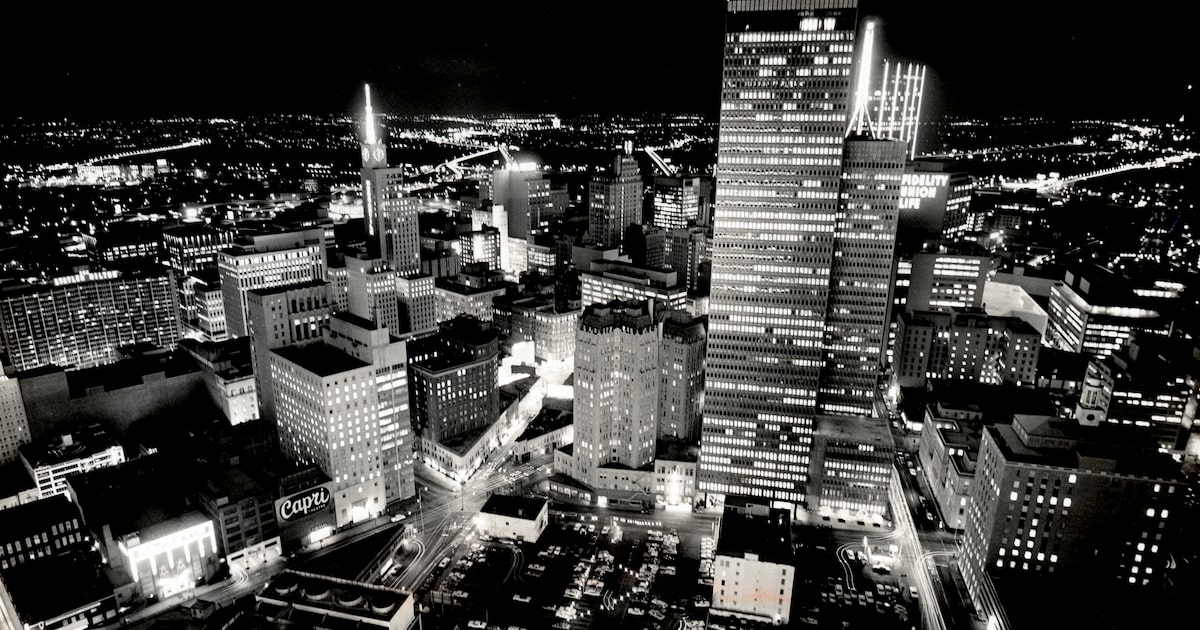
I was taking a lap around downtown Monday afternoon when I ran into a friend of a friend who knows more about the Central Business District’s real estate situation than any of the dozen developers, dreamers, cheerleaders and city employees with whom I spoke for this piece. He didn’t want to be quoted for this story. But he wanted to talk.
Because “I’m worried,” he said — and that’s all he’d let me repeat here. Because, yeah. Me, too, along with everyone else who works, lives, eats, drinks, drives through or invests in downtown. But as I’ve been reminded a lot of late, the Central Business District of old is just that – old.
“What’s happening with Klyde Warren Park, the Arts District, Uptown is remarkable,” former Mayor Mike Rawlings told me last week. “What has happened is that ‘downtown’ has moved half a mile, a mile to the left. You’re talking about old downtown. And it isn’t a business district anymore.”
I was recounting this conversation with my pal’s pal on Monday as we stood in the shadow of the Comerica building whose namesake tenant was, according to several sources, already looking to move Uptown long before its recent merger. Law firm K&L Gates, another resident of the Philip Johnson-designed high-rise, is already planning a move to the Harwood District. During Tuesday’s discussions about the state and fate of City Hall, Assistant City Manager Robin Bentley told a City Council committee there were several skyscrapers that might serve as viable replacements, Comerica’s tower among them.
Pour one out for the Mercantile?
My new friend motioned toward the green awnings a few feet away, at the foot of 1700 Pacific, which was a company-owned Starbucks until its closing a few weeks ago. One block over, tubes spilled out of the Mercantile Building’s windows, the result of a catastrophic water leak that recently transformed the historic landmark into a foul-smelling tower shedding residents as quick as its owners can terminate their leases.
Opinion
Servpro has been onsite at the Mercantile for weeks following a leak that is forcing the termination of leases and the evacuation of residents. This historic landmark was the birth of the Downtown Connection TIF District, when its Cleveland-based owners asked the city for nearly $70 million in incentives and tax abatements — 20 long years ago.
Robert Wilonsky
The Merc was one of the first downtown buildings rehabbed during that bleak period — 20 whole years ago — when it looked like downtown might go all the way down. City Hall created the Downtown Connection Tax Increment Financing District in 2005, to rescue the Mercantile, when its owners, Cleveland-based Forest City, now Brookfield Asset Management, asked for and got $63.5 million in tax abatements and incentives.
Then-Mayor Laura Miller insisted that “without turning the Merc block around, we would have no development from Neiman Marcus to Deep Ellum.”
Oh, right — Neiman Marcus, the biggest will-they-or-won’t-they since Sam and Diane on Cheers. By all accounts, it will remain open after the holiday season after all — though with a much smaller retail footprint.
My new friend and I spent about half an hour wringing our hands over downtown before shaking hands and parting ways — he toward his office, me toward Starship Bagels, which is packed every early morning with workers from AT&T.
Maybe you’ve heard: That’s another anchor also eyeing a downtown exodus. And so I’ve been told, over and over, as goes AT&T, so goes downtown, where vacancy rates already push 30%.
Just losing AT&T to a neighboring city would be a huge gut punch, bad for morale and worse for business. Its departure has been feared forever given its potential impact on downtown: an estimated 30% decrease in property values, according to Boston Consulting Group in May, costing downtown an estimated $2.7 billion in overall value.
The communications company won’t communicate its plans, refusing to address what it’s calling rumors and speculation. But there’s no escaping the cold truth that AT&T is looking toward the northern climes — Plano, so we’ve reported, possibly taking with them your Dallas Stars.
the AT&T logo looms over Commerce Street and downtown Dallas. But for how much longer?
Robert Wilonsky
Packing up for Plano, possibly
“Sports entertainment is becoming a real estate business,” the hockey team’s president and CEO, Brad Alberts, told The News recently. And the Stars, who always planned on leaving Victory Park, don’t control the real estate outside the American Airlines Center.
Mark Cuban warned us in 2017 this was going to happen when he said the Mavs would move to his land across Stemmons Freeway in the Design District. The team’s current owners now own enough land in Irving for, well, a Texas Stadium-sized development.
Once you start adding up all of these potential losses in downtown, it starts to feel overwhelming, dispiriting. The city’s center, it seems, may not hold for much longer — not even City Hall, the building then-Mayor J. Erik Jonsson commissioned to remake Dallas following the assassination of President John Kennedy, now threatened by decades’ worth of willfully deferred maintenance and at least some council members seemingly eager to plant a new arena alongside a new convention center whose final footprint and price tag we don’t even know yet.
A mayor named Erik Jonsson birthed City Hall. A mayor named Eric Johnson could preside over its demise. If nothing else, you have to appreciate the symmetry.
So many plans, so little vision
Everything you’ve read above and will find below should feel exhaustingly familiar. The city has been wrestling with its downtown for decades, as evidenced by the shelves of the Municipal Archives overspilling with hundreds of planning documents dating to the mid-1960s. Among the offerings: Housing and the Future of Downtown Dallas (from 1975), Central Business District Housing Prospects (created in 1982 by the city’s Department of Planning and Development) and, my favorite, 1966’s A Preliminary Study of Geometric Design and Parking Capacity for a Major Development in the Central Business District of Dallas.
Somewhere in my collection of local ephemera I have Corgan Associates Architects’ Downtown Dallas: 2010, Toward a Visual Master Plan to Guide Development, which, in 1989, lamented downtown’s decline toward “visual chaos and unsightly signs, wires, and debris.” That report also warned Dallas officials of the lure of the suburbs to the north, a blank canvas offering “new potential.” Same as it ever was.
From left: the Mercantile Building, which is terminating all of its leases due to a leak and noxious odor; the Comerica tower, whose namesake tenants are eyeing an Uptown move; and 1700 Pacific, which is a shell of its former self.
Robert Wilonsky
I’m old enough, too, to remember the Downtown Dallas 360 plan, introduced in 2011, adopted by the City Council and filled with “transformative strategies” and quick wins meant to make over the core — everything from street corner vendors to parking reform to transit-oriented developments. When Downtown Dallas Inc.’s then-president and CEO John Crawford unveiled the plan, I told him it would be cheaper to build a time machine to the neon-lit, streetcar-filled, office-worker-stuffed, Theater Row-lined downtown of the 1920s or 1940s than execute what the document proposed.
There’s no vision for downtown in 2025, just a bunch of landowners concerned about their corners of the CBD and a city manager trying to stop the bleeding. Which is why we’ve only slid backward since Downtown Dallas 360’s creation.
In that document, DDI fretted that “high office vacancy, between 20 and 25%, is eviden[ce] of issues such as outdated building stock and a perceived lack of parking, but also of Downtown’s desirability as a prime destination.” Office vacancy is even higher now: “26.8% vacancy with over 34 million square feet of office space,” said DDI’s current president and CEO Jennifer Scripps.
That includes the 36-story, 743,000-square-foot Harwood Center in the heart of downtown, which is now on the auction block.
A former mayor: ‘Lean into housing’
But Scripps was quick — very quick — to point out that “Denver and Seattle and Chicago are slightly higher,” with the latter at an all-time high. Scripps also pointed to the 15,000 residents in downtown, more than ever before, with a handful of sprawling apartment complexes scheduled to open on the east side of downtown in coming months.

A Dallas Historical Society photo by Lloyd Long is a dramatic night view of downtown Dallas that was taken about 1935. It shows an urban skyline dominated by the Magnolia Petroleum Building (the tallest west of the Mississippi) and its rooftop neon sign of Pegasus, “the flying red horse.”
“I would lean into housing downtown in a big way,” Rawlings told me last week. “We’ve got 15,000 residents. I’d get to 50,000, and if I had to spend city money, it may be cheaper than trying to attract corporations down there.”
Which is exactly what architecture and planning firm Gensler advocated for in 2023: downtown as a “lifestyle district.”
“One thing important for people to understand is there are all sorts of reasons why downtown matters,” Scripps said. “It’s the most important job market for residents south of I-30. It’s the brand. Our transit system goes through downtown. We’ve invested in greenspace. We have four A-rated DISD schools downtown. We have to turn all these things into assets. The body is not healthy if the heart is not healthy.”
Depending on whom you talk to, and I’ve talked to a lot of folks in recent days, it’s not all doom and gloom. This is just “downtown at a crossroads,” said Dallas Economic Development Corporation CEO Linda McMahon, formerly the head of the Real Estate Council. Or “downtown’s tipping point,” Scripps said.
Or it’s “downtown’s inflection point,” said developer Mike Ablon, who’s partnering with Hoque Global LLC namesake Mike Hoque to buy and redevelop downtown’s tallest skyscraper, the Bank of America. Hoque and Ablon say their makeover will include a hotel, a new parking garage and restaurants — at the cost of $409 million. To defray those costs, this week the City Council approved more than $103 million in incentives from the Downtown Connection TIF.
Everyone with whom I spoke for this piece had thoughts, many thoughts, about how we got here. Businesses want the shiny and new buildings seemingly announced every other day in Uptown and the suburbs. Downtown’s high-rises are aging, undesirable, unleasable. There aren’t bodies enough to sustain the storefronts that sit empty and wanting.
Oh — and downtown is unsafe, they said.
The downtown Neiman Marcus, at left, will be staying — though with a smaller retail footprint. It sits across the street from the Mercantile, whose fate is now far less certain.
Robert Wilonsky
Crime and perception
Yet in 2025, crime is actually down in downtown. As part of the Safe in the City program, there are some 120 police officers assigned to the Central Business District. According to CompStat figures provided by Downtown Dallas Inc., crime is down some 11% — save for an uptick in homicides, from two last year to five in 2025, and car break-ins, up by nearly 100 so far this year. Reports of people sleeping and drinking in public have fallen by nearly 35% since this time last year.
“We have never had that level of dedicated law enforcement from the city — those boots on the ground — in downtown,” City Manager Kimberly Bizor Tolbert said when we met at City Hall a couple of weeks ago. “Ever.”
Tolbert and I met to talk about downtown and how, seemingly, the task of keeping AT&T, Comerica, Neimans, the Stars and Mavs downtown has all fallen to her, which, let’s be honest, was bound to happen in a city with a disengaged mayor. The only caveat: Tolbert wouldn’t get into specifics about her discussions, because she wasn’t about to negotiate in public.
“I’m silent on purpose,” Tolbert said. “We are actively working on the very things that you just mentioned, whether you’re talking about AT&T, Comerica, the Mavs, the Stars. I don’t manage and do the day-to-day rumor mill because I’ll never get anything done as a leader. But I’ve met with [AT&T CEO] John Stankey, and what I can tell you is that we will continue to be at the table. We will continue to work to ensure that the things that we need to address as a city are being done.”
‘We were not losing Neiman Marcus’
Of this, there is no doubt: Tolbert, McMahon, Scripps and downtown developer Shawn Todd spared the downtown Neiman Marcus from Saks’ scalpel in March. And according to Tolbert and McMahon, the store will remain open after the holiday season — though with a smaller retail footprint among its numerous changes.

Dallas City Manager Kimberly Bizor Tolbert speaks during a Downtown Dallas Inc. press conference at the downtown Dallas Neiman Marcus on Feb. 25, 2025.
Juan Figueroa / Staff Photographer
Saks has not yet commented on the future of The Store. But Tolbert said, “We were not losing Neiman Marcus on my watch.”
The other downtown tenants, we’ll have to wait and see. Before I left, I pointed out the window of the conference room attached to Tolbert’s office, toward the blue AT&T logo looming over downtown. I said it must be hard to look out that window knowing that one day, that logo could be gone.
“We are being silent, but strategic,” she said. “We want to make sure that when I walk into this office that logo is there, period. It’s almost like it becomes a cornerstone of what continues to make this downtown Dallas shine. That’s what’s important for me, whether I’m talking about our sports teams or the Comericas of the world. It’s not lip service. It’s about making sure that they remain a part of this skyline.”

